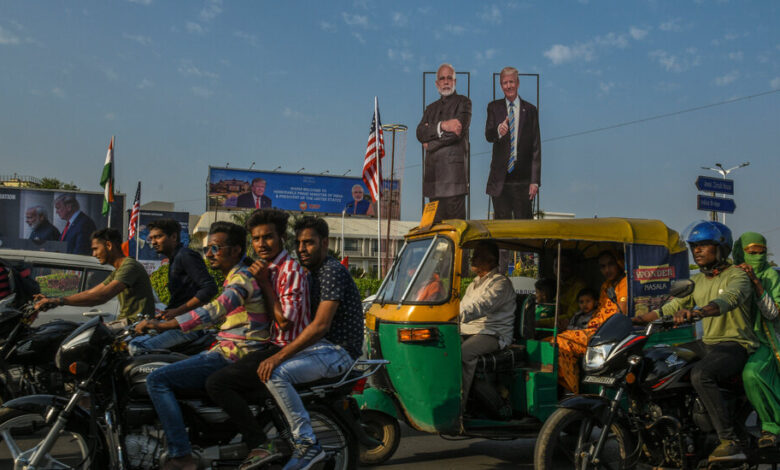What Modi and India Can Offer Trump on Trade

The economic relationship between India and the United States is widely seen as good for both sides. Two-way trade is growing and, alone among Asian countries, India routinely trades more with the United States than it does with China, its neighbor and rival.
Yet under President Trump, trade is a point of friction. Like virtually all countries that do business with the United States, India runs a surplus: Last year it shipped about $87 billion worth of goods and imported $42 billion, adding $46 billion to America’s trade deficit.
Mr. Trump does not like those kinds of figures. He has railed against countries that sell more to the United States than they buy. Cue his furious imposition of tariffs on both allies and foes, provoking threats of retaliation and unsettling global commerce.
During his first term, President Trump called India “the tariff king.” He pointed to Indian duties as high as 100 percent on some American goods. He was particularly focused on a tariff he said was blocking Harley-Davidson from exporting more motorcycles. When India’s trade officials reduced that tariff, Mr. Trump paraphrased them: “ ‘We want to keep your president happy.’ Isn’t that nice?”
This week, when Mr. Trump sits down in Washington with Narendra Modi, India’s prime minister, tariffs are expected to be a topic of conversation again. Here’s what you need to know about the trading relationship between India and the United States.
Is India really taking advantage of American trade?
India’s trade surplus with the United States has been growing under Mr. Modi, who took office in 2014. What had been about $20 billion to $24 billion annually shot up to $33 billion in 2021. But importantly, back-and-forth trade between the two has been growing at a similar rate: As a percentage of the total, the surplus has stayed nearly steady.
India has a complicated list of tariffs. There are hundreds of categories taxed at different rates, which can change wildly from year to year. That is a legacy from India’s colonial era, when Britain used trade practices in exploiting its resources.
Since 1990, when India oriented its economy more to world trade and investment, the average tariff rate has fallen, from 125 percent to below 5 percent on most goods imported from the United States.
Unlike most Asian countries, India has its own trade deficit to worry about. The United States has the world’s biggest, at $1.2 trillion, but that amounts to less than 4 percent of its economy. Richard Rossow, who follows India at the Center for Strategic and International Studies in Washington, pointed out that India, which depends on imports for most of its fuel needs, runs a deficit worth between 8 and 12 percent most years. That has driven down the value of India’s currency, the rupee, to painful levels.
What does India trade with America?
Most of what these two countries trade falls under the category of oil and petrochemicals, or that of gems. In both cases, the United States ships vast quantities of raw or semi-processed material to India, where refineries or gem-cutters process them in their workshops. In some cases, the finished goods go right back to the United States.
Other important parts of their economic relationship include the trade in services, including financial investment and high-end professional work that is being done for American companies by staff sitting in India. But Mr. Trump has focused on trade in goods.
What could India do to satisfy Trump?
That leaves only a bit of wiggle room for the two leaders. “Going back to the first Trump administration, getting India to buy more U.S. hydrocarbons was top of the list, along with defense items,” Mr. Rossow said. Last week, Mr. Trump claimed a victory after meeting with Japan’s prime minister, Shigeru Ishiba, saying he had agreed to import more liquefied natural gas.
India has spent between $1.5 billion and $4 billion on American defense imports in recent years, and would have trouble taking on expensive new systems, like fighter jets. It has outstanding orders from Russian and French suppliers. Still, weapons and gas, which India’s national government can buy on its own, hold promise as a way to tamp down the trade imbalance.
There is some room for India to make offerings on tariffs. American producers of bourbon and pecans are hoping that Mr. Trump might knock down trade barriers keeping them from Indian consumers. Similar restrictions on poultry and California almonds have already been eased. Indian demand for such goods is minimal, but in trade negotiations, a lower tariff is a lower tariff.
Then, of course, there is Milwaukee-based Harley-Davidson. The company’s heavyweight bikes are hit by 50 percent tariffs on their way to India, though as of May 1, that will lower to 30 percent after a recent change by Mr. Modi’s government. Since 2020, Harley had exported only a few hundred bikes a year to India. Last year, it teamed up with a local manufacturer, devised a model that retails for around $3,000, and sold more than 14,000. But none of them counted as imports.




